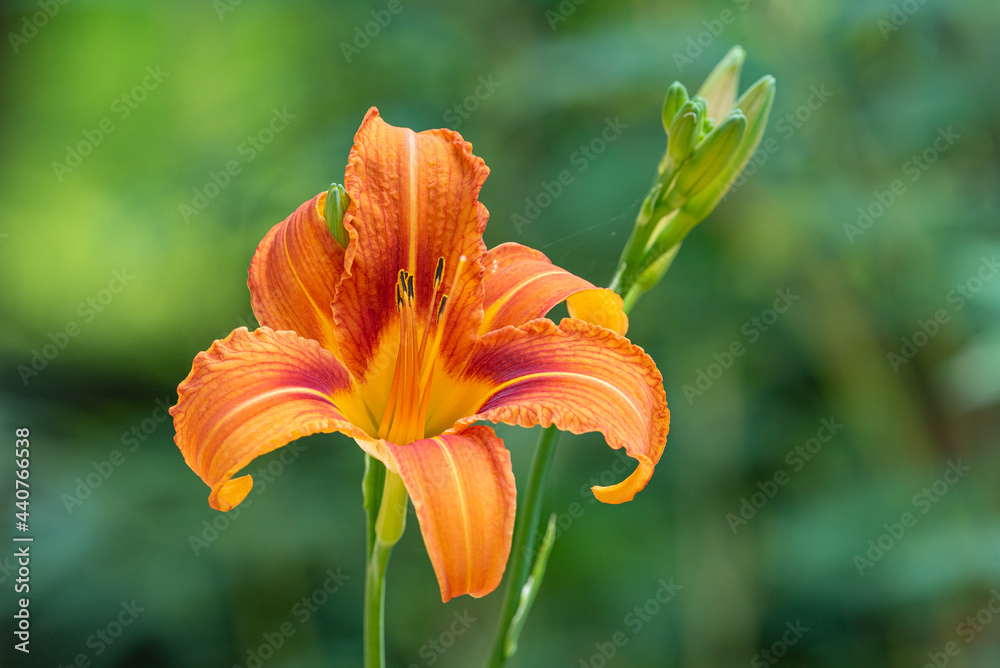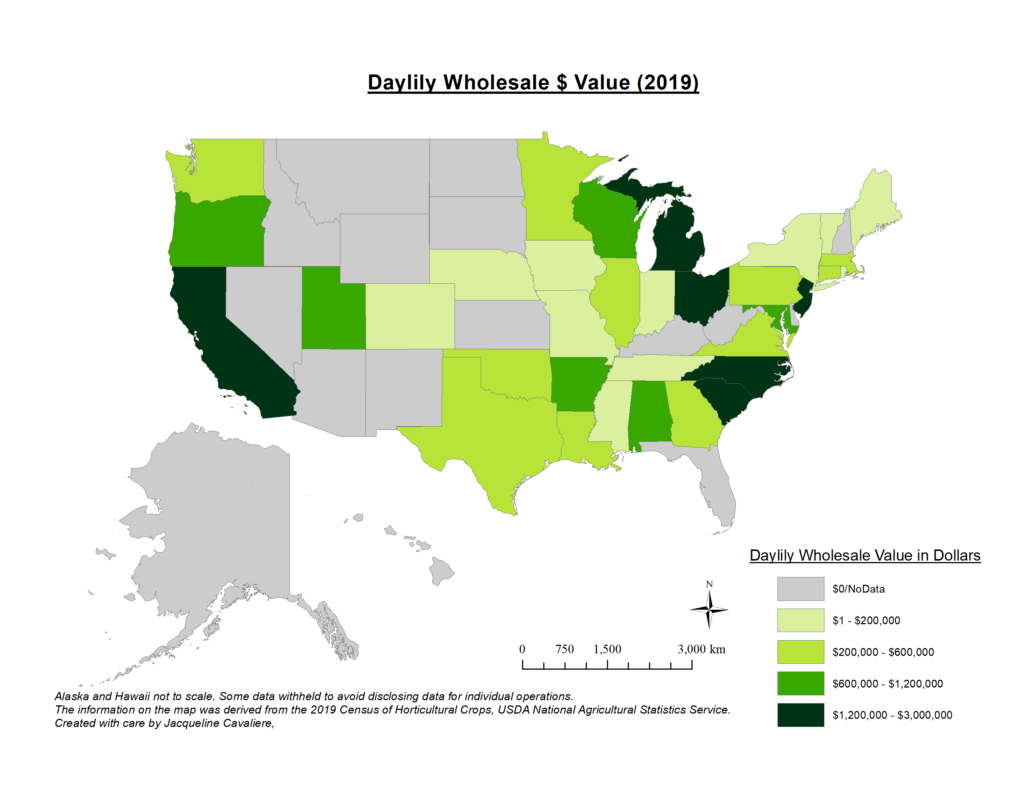Plant Information
Daylilies are flowering plants in the genus Hemerocallis, a member of the family Asphodelaceae. Their scientific name, Hemerocallis, is from the Greek hemeros, a day, and kallos, meaning beauty, because the flowers are only open a single day. Despite the name, daylilies are not true lilies, although the flower has a similar shape. These plants are native to China, Japan, Korea, and neighboring eastern Asia, where they have been cultivated for more than 4,000 years. Daylilies arrived in Europe from China, Japan, Korea, and Eastern Siberia, during the 16th century, and by the 17th century were first brought to North America by early European immigrants. By the early 1800s, the plant had become naturalized, and a bright orange clump of flowers was a common sight in many homestead gardens. This genus is popular worldwide because of the showy flowers and hardiness of many kinds. There are 16 recognized Hemerocallis species, two of which are the foundational species for most modern varieties: the tawny daylily Hemerocallis fulva, a native to Asia and common along roadsides in much of North America, and the lemon daylily H. lilioasphodelus (formerly H. flava). At this time there are over 80,000 registered varieties.
Daylilies are useful in the perennial flower border, planted in large masses, as ground cover on slopes, as single specimen clumps, or in pots and containers. The many varieties come in myriad colors, sizes, and shapes, and they are incredibly low-maintenance flowers that are suitable for almost any type of landscape. Bloom times can continue from late spring on into fall. The hardy daylily can be grown from USDA zones 3 to 9, so they can tolerate both summer heat and humidity, as well as returning each year after cold winters. They are drought-resistant and easy to grow in most soil and light conditions. Although the daylily is a very forgiving plant it does appreciate the care and rewards the gardener with more prolific blooming. It enjoys full sun but 6 hours a day will be sufficient during bloom time. They are not fussy about soil pH but ideally like to be in very slightly acidic conditions. They will do fine in sandy soils, clay, and chalky soil but, like most plants, appreciates light humus-enriched soil. They are not heavy feeders but enjoy a yearly application of compost or manure and a basic 10-10-10 fertilizer in the spring and during bloom. They are very drought-tolerant but bloom best with generous watering. Daylilies can be aggressive spreaders and will likely require dividing at some point (usually every 3 to 5 years). In addition to controlling their spread, dividing will also reinvigorate plants, resulting in better and more frequent blooms.
Daylilies are well suited to container life, as long as they have enough room to grow. The smaller the variety, the better they will be able to grow in pots and containers. As a rule, plant full-sized daylilies in a gallon or larger container. Growing daylilies in containers isn’t much different from growing them in the ground; both are easy and low-maintenance. When planting in containers, make sure to use pots with drainage holes. Fill the container with potting soil and place containers in a spot that receives at least 6 hours of sun per day. Container plants always dry out faster than their garden counterparts, and in the heat of summer watering about once a day is recommended. Daylilies are very cold hardy, but container plants are always more susceptible to winter damage. In USDA zone 7 or below, containers should be kept in an unheated garage or basement to keep them safe. As soon as spring comes, containers can be moved back out into the sun to get them blooming again quickly.
Economics
According to the USDA NASS Census of Horticulture, total sales for daylilies was $29.9M in 2019.
 Main Disease Problems
Main Disease Problems
Common disease problems of daylilies are daylily leaf streak (Aureobasidium microstictum), daylily rust (Puccinia hemerocallidis), root-knot nematodes (Meloidogyne spp.), and Colletotrichum leaf spot or leaf scorch (Colletotrichum dematium). Other diseases affecting daylilies include bacterial soft rot, Rhizoctonia crown rot, russet spot, and white mold.
Main Pest Problems
Common pests of daylilies are aphids, flower thrips (Frankliniella tritici), two-spotted spider mites (Tetranychus urticae), daylily leafminer (Ophiomyia kwansonis), and slugs & snails. Other insect pests affecting daylilies include cutworms, tarnished plant bugs, cucumber beetles, Japanese beetles, grasshoppers, and periodical cicadas.
IR-4 Research
IR-4 has sponsored 172 crop safety trials with 58 products, and we have screened 12 new actives with daylilies for effective management of daylily leafminer (Ophomyia kwansonis) and northern root-knot nematode (Meloidogyne hapla).
Sources Cited
https://en.wikipedia.org/wiki/Daylily
http://khkeeler.blogspot.com/2018/05/plant-story-daylilies-from-asia.html
http://www.daylilydiary.com/gardenH.htm
https://strictlydaylilies.com/pages/the-daylily-hemerocallis
https://www.gardendesign.com/flowers/daylilies.html
https://www.gardeningknowhow.com/ornamental/bulbs/daylily/growing-daylilies.htm
https://www.gardeningknowhow.com/ornamental/bulbs/daylily/growing-daylilies-in-containers.htm
https://dengarden.com/gardening/How-to-Care-for-Dependable-Disease-Resistant-Carefree-Day-Lilies
https://www.almanac.com/plant/daylilies
https://extension.psu.edu/hemerocallis-daylily-diseases
https://citybugs.tamu.edu/2013/05/22/new-pest-of-lilies-in-texas/
https://midatlanticgardener.com/daylily-common-pests-problems/
https://smokeysgardens.com/blog/a-closer-look-at-the-biggest-problems-with-daylilies-pests-and-diseases/
USDA-NASS Census of Horticulture, 2019
Authors
Ely Vea, IR-4 Environmental Horticulture Program Assistant Manager and Jacqueline Cavaliere, IR-4 Environmental Horticulture Program Coordinator.


